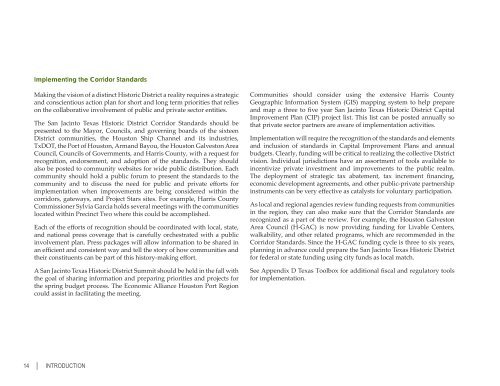design elements - San Jacinto Texas Historic District
design elements - San Jacinto Texas Historic District
design elements - San Jacinto Texas Historic District
You also want an ePaper? Increase the reach of your titles
YUMPU automatically turns print PDFs into web optimized ePapers that Google loves.
Implementing the Corridor Standards<br />
Making the vision of a distinct <strong>Historic</strong> <strong>District</strong> a reality requires a strategic<br />
and conscientious action plan for short and long term priorities that relies<br />
on the collaborative involvement of public and private sector entities.<br />
The <strong>San</strong> <strong>Jacinto</strong> <strong>Texas</strong> <strong>Historic</strong> <strong>District</strong> Corridor Standards should be<br />
presented to the Mayor, Councils, and governing boards of the sixteen<br />
<strong>District</strong> communities, the Houston Ship Channel and its industries,<br />
TxDOT, the Port of Houston, Armand Bayou, the Houston Galveston Area<br />
Council, Councils of Governments, and Harris County, with a request for<br />
recognition, endorsement, and adoption of the standards. They should<br />
also be posted to community websites for wide public distribution. Each<br />
community should hold a public forum to present the standards to the<br />
community and to discuss the need for public and private eff orts for<br />
implementation when improvements are being considered within the<br />
corridors, gateways, and Project Stars sites. For example, Harris County<br />
Commissioner Sylvia Garcia holds several meetings with the communities<br />
located within Precinct Two where this could be accomplished.<br />
Each of the eff orts of recognition should be coordinated with local, state,<br />
and national press coverage that is carefully orchestrated with a public<br />
involvement plan. Press packages will allow information to be shared in<br />
an effi cient and consistent way and tell the story of how communities and<br />
their constituents can be part of this history-making eff ort.<br />
A <strong>San</strong> <strong>Jacinto</strong> <strong>Texas</strong> <strong>Historic</strong> <strong>District</strong> Summit should be held in the fall with<br />
the goal of sharing information and preparing priorities and projects for<br />
the spring budget process. The Economic Alliance Houston Port Region<br />
could assist in facilitating the meeting.<br />
14 │ INTRODUCTION<br />
Communities should consider using the extensive Harris County<br />
Geographic Information System (GIS) mapping system to help prepare<br />
and map a three to fi ve year <strong>San</strong> <strong>Jacinto</strong> <strong>Texas</strong> <strong>Historic</strong> <strong>District</strong> Capital<br />
Improvement Plan (CIP) project list. This list can be posted annually so<br />
that private sector partners are aware of implementation activities.<br />
Implementation will require the recognition of the standards and <strong>elements</strong><br />
and inclusion of standards in Capital Improvement Plans and annual<br />
budgets. Clearly, funding will be critical to realizing the collective <strong>District</strong><br />
vision. Individual jurisdictions have an assortment of tools available to<br />
incentivize private investment and improvements to the public realm.<br />
The deployment of strategic tax abatement, tax increment fi nancing,<br />
economic development agreements, and other public-private partnership<br />
instruments can be very eff ective as catalysts for voluntary participation.<br />
As local and regional agencies review funding requests from communities<br />
in the region, they can also make sure that the Corridor Standards are<br />
recognized as a part of the review. For example, the Houston Galveston<br />
Area Council (H-GAC) is now providing funding for Livable Centers,<br />
walkability, and other related programs, which are recommended in the<br />
Corridor Standards. Since the H-GAC funding cycle is three to six years,<br />
planning in advance could prepare the <strong>San</strong> <strong>Jacinto</strong> <strong>Texas</strong> <strong>Historic</strong> <strong>District</strong><br />
for federal or state funding using city funds as local match.<br />
See Appendix D <strong>Texas</strong> Toolbox for additional fi scal and regulatory tools<br />
for implementation.


